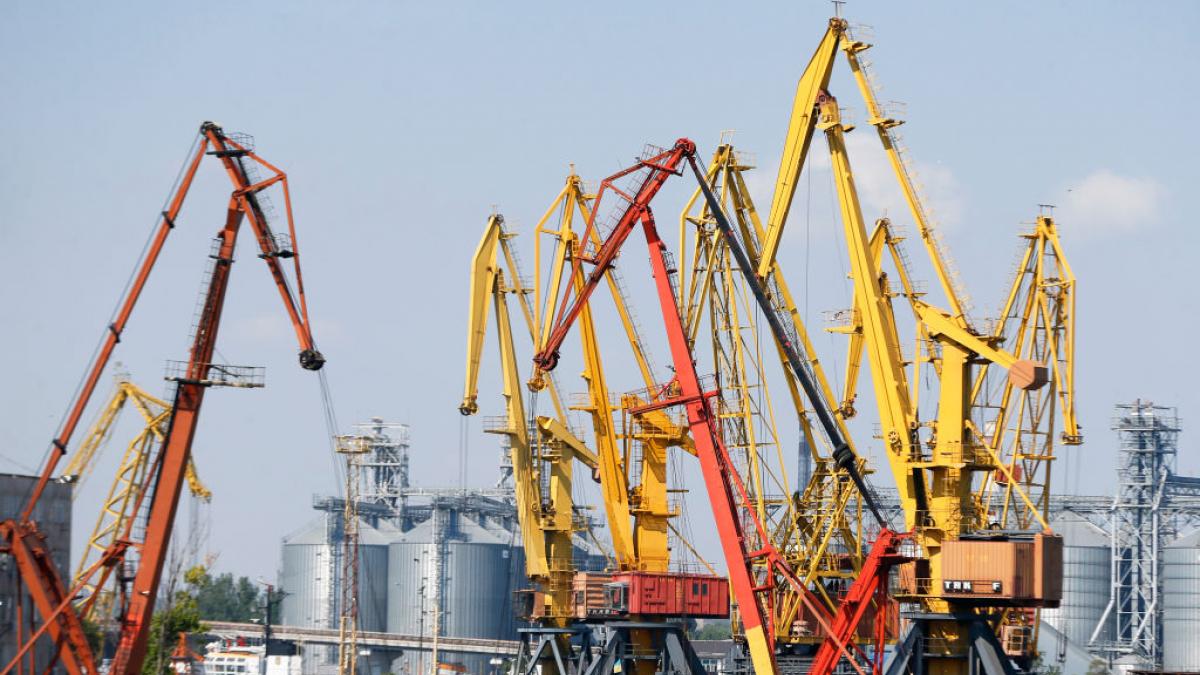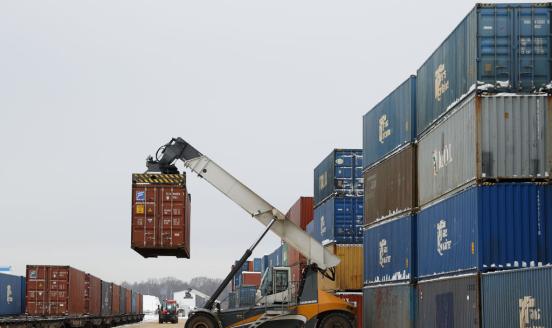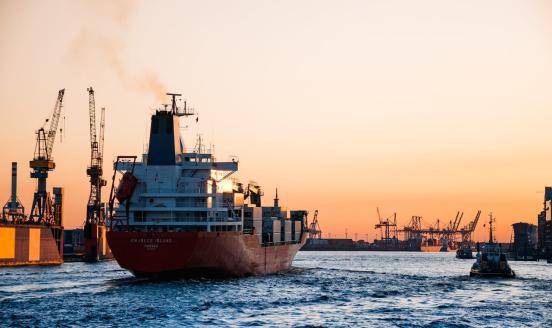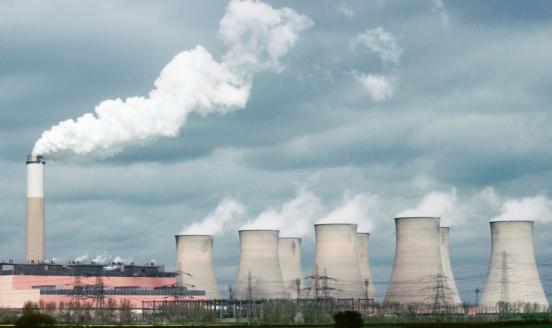Russia’s huge trade surplus is not a sign of economic strength
Russia has recorded a record trade surplus, but more than half of its increase is due to the collapse of imports.

In the second quarter of 2022, Russia recorded its highest ever current-account surplus, primarily due to a record-breaking trade surplus (Figure 1). This partly reflects higher fossil-fuel revenues resulting from higher prices, which have helped finance Putin’s war.
But extra revenue from higher energy prices is just part of the story. Slightly more than half of the increase in Russia’s trade surplus is due to drastically falling Russian imports, which could ultimately undermine Russia’s productive capacity.
Russia’s central bank stopped publishing detailed trade data after Russia invaded Ukraine, so we collected detailed data from European Union countries, China, the United States, South Korea, Japan, India, the United Kingdom and Turkey, and decomposed the changes in Russia’s trade surplus. These 34 countries accounted for around 75% of Russia’s exports and imports in 2019. The decline in Russian imports of products sanctioned by advanced countries is greater than the decline of non-sanctioned goods imports, suggesting that sanctions have influenced trade flows. This runs counter to the idea that Russia’s large trade surplus reflects the inefficiency of western sanctions.
The slight pick-up in Russia’s imports in June 2022 compared to the preceding two months (Figure 1) does not invalidate this conclusion.
Russia’s energy exports have diverted towards India and China, though the EU still accounted for more than half of Russian energy export revenues in June 2022. Turkey gained a large share of Russian non-energy exports, as the EU’s share declined to 40%.
The impact of the war on trade in goods with Russia
Russia’s monthly trade surplus with the 34 countries we study fluctuated between $10 billion and $15 billion in 2019 (the most recent year without a major global shock; Figure 1).
The surplus for mineral fuels and related products was $15 billion to $20 billion per month, while for other goods Russia recorded a deficit of about $5 billion/month. COVID-19 depressed mineral fuel revenues, as demand and prices declined. From early 2021, however, mineral fuel demand and prices started to increase and thus so did revenues. There was a sudden jump with the start of the war.
The war also brought about a jump in Russia’s trade balance on goods other than mineral fuels: in March and April 2022, monthly surpluses ran at approximately $5 billion – an increase of about $10 billion/month from the pre-war period. This had declined somewhat by June 2022.
From the overall $60.1 billion 2021Q2 to 2022Q2 increase in Russia’s trade surplus with the 34 countries, mineral fuels accounted for $29.4 billion, while goods other than mineral fuels accounted for $30.7 billion. Almost half of the latter resulted from the drop in sales by the 34 countries of machinery and transport equipment to Russia, which will likely undermine Russia’s ability to produce advanced technological products, including military equipment.
Meanwhile, Russian exports to the 34 countries steadily increased until March 2022, followed by a sizeable drop (Figure 2).
The drop in Russian imports has been much more dramatic: the average value in March-June 2022 was just half of the average value in the preceding four months (Figure 3). Russia’s imports from every country, including China, dropped substantially. This affected all major product categories. Still, in May and June 2022, there was some recovery (except for Russia’s imports from the US, which continued to fall). The strongest recovery was seen in Turkey’s exports to Russia, which in June 2022 exceeded pre-war levels.
The much bigger drop in Russia’s non-fossil fuel imports than in its exports of these goods could reflect sanctions (though most sanctions did not take immediate effect; see the annex). It could also reflect the difficulties Russian companies have in paying for imports, partly because several Russian banks have been sanctioned, making it more difficult for their clients to make payments abroad, and partly because, since the war started, Russian companies must convert 80% (recently reduced to 50%) of hard currency revenues to rubles with the Bank of Russia. Reduced activities of foreign companies in Russia might have also contributed to falling Russian imports, as has the initial substantial depreciation of the Russian ruble.
The rebound of Russia’s imports in May and June 2022 might have been helped by the ruble's recovery and relative stability, and the fact that some companies initially went further than sanctions in halting business with Russia. With a better understanding of sanctions, some activities have been resumed.
Sanctioned goods
Sanctions have included prohibitions by several countries of exports to Russia of strategic goods, including high-tech goods and components for use in electronics, telecommunications, aerospace and oil refining, among other sectors. US sanctions apply not only to goods exported by US companies, but also to goods produced elsewhere using US technologies. The extra-territorial nature of US sanctions could help explain the generalised drop in Russia’s imports since March 2022, even from countries that have not applied sanctions.
Categories in the 2-digit level classification for the Standard International Trade Classification (SITC) we use do not correspond precisely to sanctioned products. Categories that surely include sanctioned items also include non-sanctioned items. Nevertheless, for Figure 4, we selected some categories which could be dominated by sanctioned items.
The decline in Russia’s imports from the 34 countries from February to June 2022 was 31% for all goods, but 59% for five 2-digit level of SITC product categories that include sanctioned products (Figure 4). Thus, Russia’s imports of sanctioned products have declined much more than imports of other products, suggesting that sanctions have influenced trade flows.
Strikingly, Russia’s imports of the five product categories from the EU, US, UK, Japan and South Korea, which imposed sanctions, declined by 76% from February to June 2022. But from China, India and Turkey, which did not impose sanctions, the decline was just 26%. There was even a significant increase in Russia’s imports from Turkey in almost all product categories.
The US, EU and UK announced plans to phase out Russian sources of energy, and mineral fuel exports from Russia to the US and UK fell to zero by May and June respectively (Figure 5). Russian gas exports to the EU have reduced, but the trend is less clear for coal and oil. The EU has not introduced limits on Russian gas, but supply cuts explain the reduction. The fluctuation in Russian oil and coal exports to the EU may hint at attempts to compensate, in the short-term, for shortfalls in other energy sources ahead of deadlines to phase out fully coal (August 2022) and oil and oil products (December 2022 and February 2023, with exceptions for crude oil by pipeline and for Bulgaria and Croatia).
EU trade with Russia, value and weight decomposition
The values reported so far are in US dollars and reflect both quantity changes and price changes. Unfortunately, separating quantity and price is not possible. However, Eurostat publishes trade data in both current prices and kilogrammes. The latter can be an indirect and imperfect proxy for quantity: a kilo of paper weighs the same as a kilo of gold, but their values differ greatly. The weight of products can be a good proxy for quantities only if the shares of different products in total trade do not change and there are no quality changes. Nevertheless, it is instructive to plot the value and weight of exports and imports (Figures 6 and 7). The values and weights track one another for Russian imports from the EU, suggesting small price effects. But Russian exports to the EU show major variations, driven by changes in mineral fuel exports, suggesting major price effects, including the drop in prices in early 2020 when the COVID-19 crisis hit, and a sustained increase in prices since then.
Where Russian exports go
The breakdown of Russia’s mineral fuel exports to the 34 countries allows recent trade diversion effects to be identified (Figure 8). Russia’s mineral fuel exports to the EU have declined from a peak in February 2022. The decline has been faster than the overall decline in Russian mineral fuels exports; thus the EU share dropped from 62% to 52% (February to June). Meanwhile, there has been a significant increase in both the quantity and the share of these exports going to China and, especially, to India. The US and the UK have completely phased out Russian-sourced fossil fuels, and South Korea and Japan have been on a declining trend since the war started.
As for changes in the destination of Russian goods other than mineral fuels, there has been a clear increase in Turkey’s overall weight (from 21% in February 2022 to around 31% in June), while Russia’s exports to the UK have stopped almost completely (Figure 9). The shares of Russian exports going to the US, EU, Japan and South Korea have also decreased since March 2022.
We will issue an updated Russian trade dataset after the July 2022 data becomes available in mid-September.
ANNEX: Trade-related sanctions imposed on Russia
We have focused on trade-related sanctions imposed on Russia since February 2022 by the US, EU, UK, Japan and South Korea. China, India and Turkey have not joined other countries in imposing sanctions on Russia in response to the invasion of Ukraine. China has even acted to favour coal imports from Russia, with a tariff cut to zero.
Bans on exports to Russia
The US announced on 24 February 2022 stringent export controls that aimed to severely restrict Russia’s access to technologies and other items needed to sustain its military capabilities. The export controls also restrict foreign goods produced using US technology (for instance, equipment, software, and blueprints). Items targeted for export controls include semiconductors, computers, telecommunications, information security equipment, lasers and sensors. The EU, UK, Japan and South Korea also announced bans on exports to Russia of various strategic goods, including high-tech goods and components for use in sectors including electronics, telecommunications, aerospace and oil refining.
Following the G7 meeting on 11 March, G7 countries announced export bans on luxury goods. After the 27 June G7 meeting, importing gold from Russia was also prohibited. Other products added to the lists of sanctioned goods of various countries include wood, machinery, cutting-edge goods such as quantum computers, iron and steel, and spirit drinks.
Bans on imports from Russia – a focus on fossil fuels
The US, EU and the UK all announced plans to phase out Russian sources of energy. On 8 March, the US announced a ban on imports of Russian fuels, including oil, liquefied natural gas and coal. For contracts agreed before this date, the ban became effective on 22 April. By May, US imports of Russian mineral fuels had declined to zero (Figure 5).
The UK first announced plans to phase out Russian oil by the end of 2022, then said it would also end all imports of Russian coal by the end of 2022, and of gas as soon as possible. Trade data shows that in June the UK had already phased out completely all types of mineral fuel imports from Russia (Figure 5).
The EU said on 8 April it would prohibit coal imports starting from August 2022, and two months later added it would also prohibit imports of crude oil and certain petroleum products, effective from December 2022 and February 2023, respectively (with exceptions for crude oil by pipeline and also for Bulgaria and Croatia).



